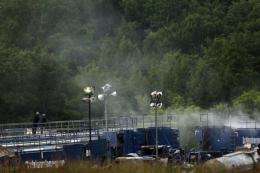Marcellus brine migration likely natural, not man-made: study

A Duke University study of well water in northeastern Pennsylvania suggests that naturally occurring pathways could have allowed salts and gases from the Marcellus shale formation deep underground to migrate up into shallow drinking water aquifers.
The study found elevated levels of salinity with similar geochemistry to deep Marcellus brine in drinking water samples from three groundwater aquifers, but no direct links between the salinity and shale gas exploration in the region.
"This is a good news-bad news kind of finding," said Avner Vengosh, professor of geochemistry and water quality at Duke's Nicholas School of the Environment.
The good news, he said, is that it's unlikely that hydraulic fracturing for shale gas has caused the elevated salinity. He said the locations of the samples containing brine don't correlate with the locations of shale-gas wells. The results from the new study also are consistent with water-quality tests conducted in the aquifers in the 1980s before rapid shale-gas development began.
The bad news is that the geochemical fingerprint of the salinity detected in well water from the Lock Haven, Alluvium and Catskill aquifers suggests a network of natural pathways exists in some locations, especially in valleys. These pathways allowed gases and Marcellus brine to migrate up into shallow groundwater aquifers from deeper underground shale gas deposits.
"This could mean that some drinking water supplies in northeastern Pennsylvania are at increased risk for contamination, particularly from fugitive gases that leak from shale gas well casings," Vengosh said.
Last May, the Duke team published the first peer-reviewed paper that found elevated levels of methane contamination in drinking water wells located within a kilometer of hydraulic fracturing, or "fracking," shale gas wells, but found no evidence of contamination from fracturing fluids or brines.
The new paper complements that study by showing "there are likely pathways through which methane and brine could flow," Vengosh said. The Duke team evaluated 426 samples from groundwater aquifers in six counties overlying the Marcellus shale formation in northeastern Pennsylvania.
The study appears this week in the online early edition of the Proceedings of the National Academy of Sciences. It was funded by Duke's Nicholas School of the Environment.
"The small group of homes whose water we sampled may be at higher risk of contamination due to underlying geology," said Nathaniel Warner, a PhD student at Duke who was lead author on the study. "By identifying the geochemical fingerprint of Marcellus brine, we can now more easily identify where these locations are and who these homeowners might be."
Robert B. Jackson, Nicholas Professor of Global Environmental Change and director of Duke's Center on Global Change, co-authored the paper with Warner and Vengosh. He said, "These results reinforce our earlier work showing no evidence of brine contamination from shale gas exploration. They do, however, highlight locations and homeowners more is vulnerable to contamination, something we'll need to follow up."
The new findings also should help address concerns about barium contamination in local drinking water, Warner said.
"Especially in valleys in the region, elevated salinity is associated with barium contamination in the water," Warner said. "Our study's findings suggest that homeowners living in these areas are at higher risk of contamination from metals such as barium and strontium."
The Marcellus shale formation is located about a mile underground and contains highly saline water that is naturally enriched with salts, metals and radioactive elements.
Hydraulic fracturing, also called hydrofracking or fracking, involves pumping water, sand and chemicals deep underground into horizontal gas wells at high pressure to crack open hydrocarbon-rich shale and extract natural gas. Accelerated shale gas drilling and hydrofracking in the northeastern Pennsylvania region in recent years has fueled concerns about water contamination by methane, fracking fluids and wastewater from the operations.
"As shale gas exploration is becoming global -- including in Poland, China, Australia and New Zealand -- the take-home message of this study is that pre-drilling water quality monitoring is important for evaluating water-quality baselines that can be used to detect future changes in water quality, and for evaluating possible hydraulic 'short cuts' and pathways between fluids and gases in deep shale gas formations and shallow aquifers," said Vengosh. "Such geochemical reconnaissance would provide a better risk assessment for water contamination in newly developed shale gas exploration areas."
More information: “Geochemical evidence for possible natural migration of Marcellus Formation brine to shallow aquifiers in Pennsylvania,” by Nathaniel R. Warner et al. PNAS.
Journal information: Proceedings of the National Academy of Sciences
Provided by Duke University















